Analyzing Societal Progress: Statistical Methods and Development
VerifiedAdded on 2023/01/16
|10
|3090
|76
Report
AI Summary
This report explores the efficacy of advanced statistical methods in assessing societal progress. It begins with an executive summary and an introduction to the role of statistics in planning, monitoring, and evaluating development activities. The report then delves into the impact of key indicators such as inflation rate, labor force, health outcomes, income per capita, GDP, and poverty headcount on societal development. Furthermore, it examines the role of statistics in global monitoring, including the Millennium Development Goals (MDGs) and Sustainable Development Goals (SDGs). The report emphasizes the importance of reliable and timely statistical information for creating effective economic policies, monitoring progress, and ensuring equitable and strong development. The report concludes by highlighting how statistics drive results and provide evidence for effectual policy development. The report provides examples of how statistics are used in various contexts, such as weather forecasting, poverty measurement, and government budget allocation, demonstrating its critical role in various aspects of society.
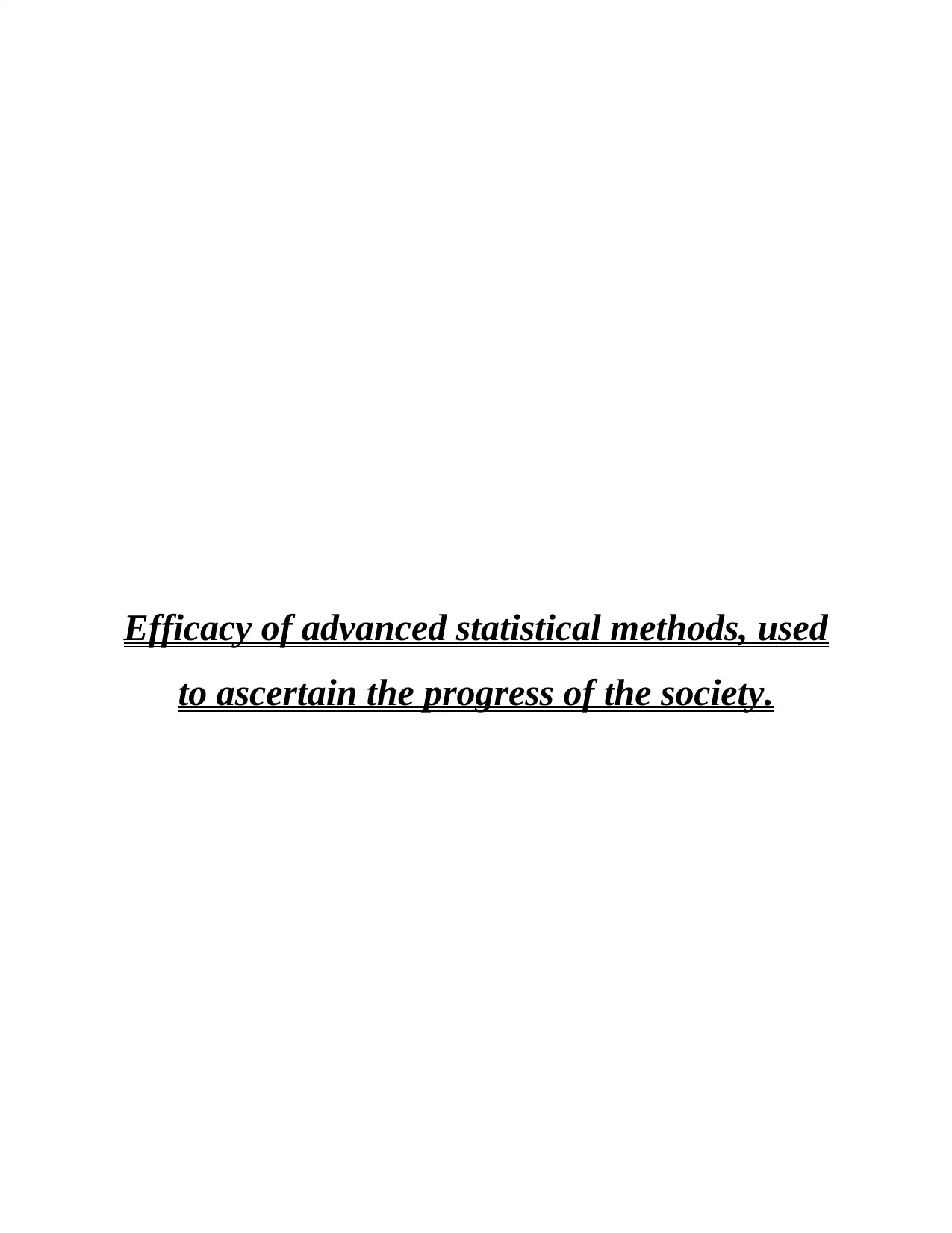
Efficacy of advanced statistical methods, used
to ascertain the progress of the society.
to ascertain the progress of the society.
Paraphrase This Document
Need a fresh take? Get an instant paraphrase of this document with our AI Paraphraser
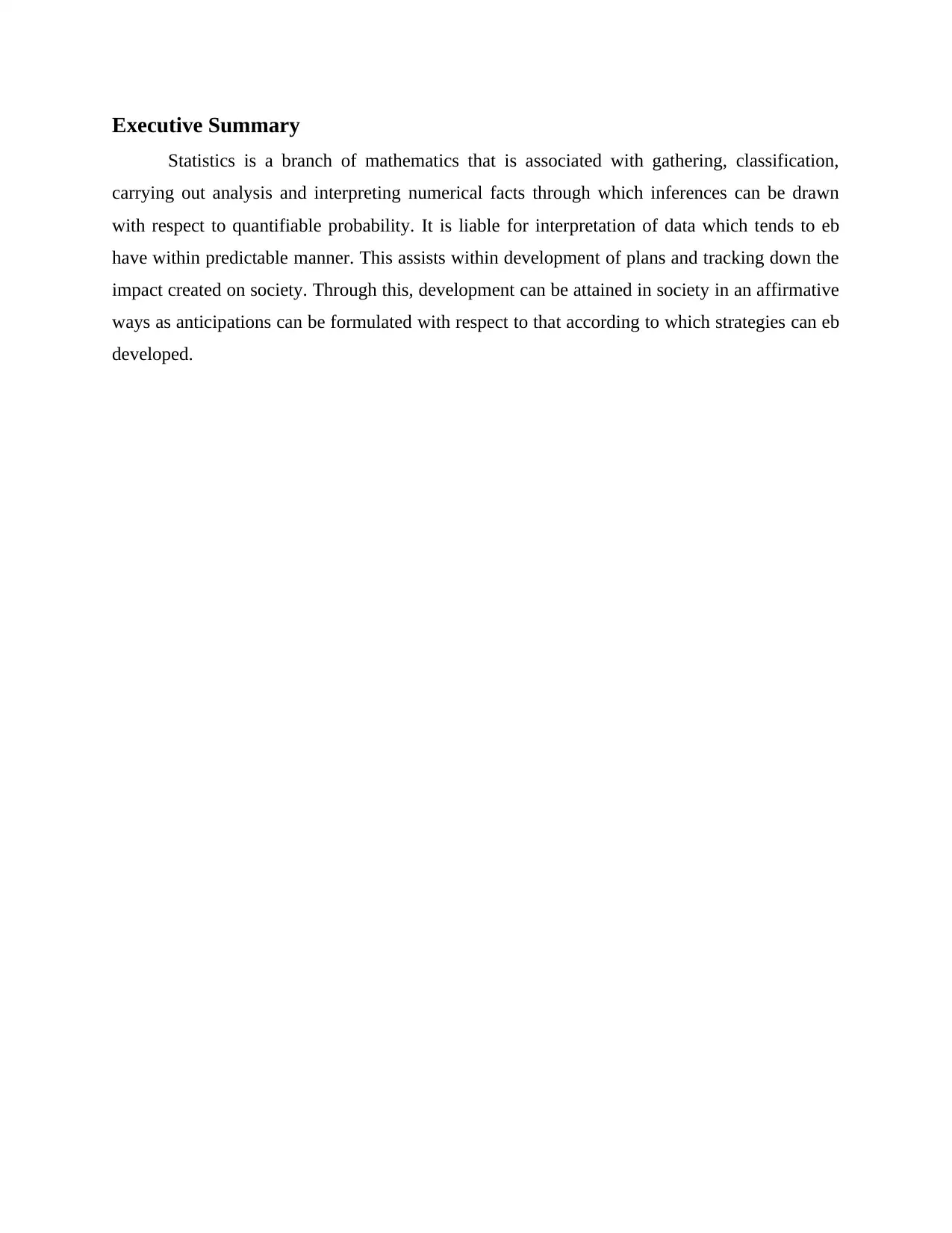
Executive Summary
Statistics is a branch of mathematics that is associated with gathering, classification,
carrying out analysis and interpreting numerical facts through which inferences can be drawn
with respect to quantifiable probability. It is liable for interpretation of data which tends to eb
have within predictable manner. This assists within development of plans and tracking down the
impact created on society. Through this, development can be attained in society in an affirmative
ways as anticipations can be formulated with respect to that according to which strategies can eb
developed.
Statistics is a branch of mathematics that is associated with gathering, classification,
carrying out analysis and interpreting numerical facts through which inferences can be drawn
with respect to quantifiable probability. It is liable for interpretation of data which tends to eb
have within predictable manner. This assists within development of plans and tracking down the
impact created on society. Through this, development can be attained in society in an affirmative
ways as anticipations can be formulated with respect to that according to which strategies can eb
developed.
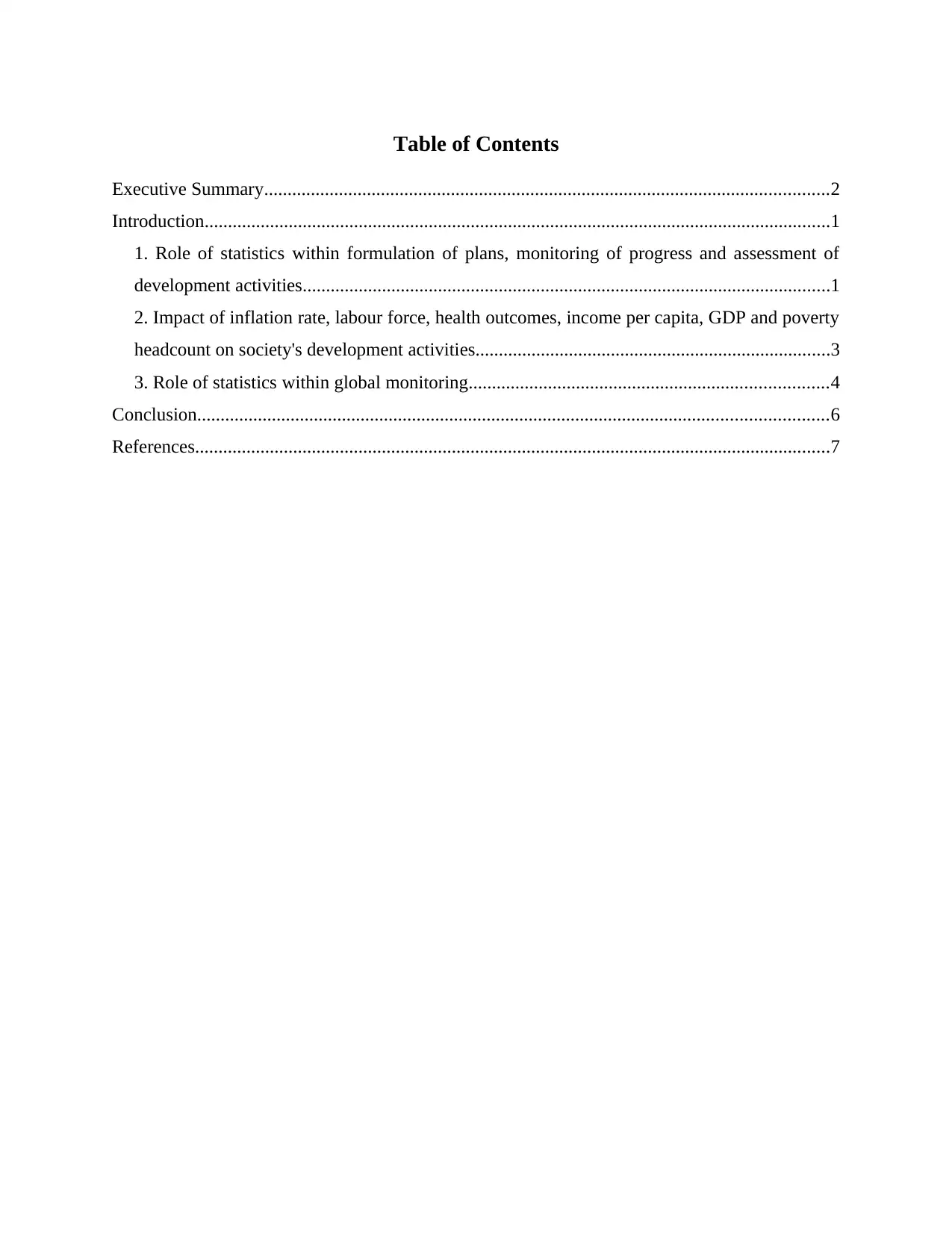
Table of Contents
Executive Summary.........................................................................................................................2
Introduction......................................................................................................................................1
1. Role of statistics within formulation of plans, monitoring of progress and assessment of
development activities.................................................................................................................1
2. Impact of inflation rate, labour force, health outcomes, income per capita, GDP and poverty
headcount on society's development activities............................................................................3
3. Role of statistics within global monitoring.............................................................................4
Conclusion.......................................................................................................................................6
References........................................................................................................................................7
Executive Summary.........................................................................................................................2
Introduction......................................................................................................................................1
1. Role of statistics within formulation of plans, monitoring of progress and assessment of
development activities.................................................................................................................1
2. Impact of inflation rate, labour force, health outcomes, income per capita, GDP and poverty
headcount on society's development activities............................................................................3
3. Role of statistics within global monitoring.............................................................................4
Conclusion.......................................................................................................................................6
References........................................................................................................................................7
⊘ This is a preview!⊘
Do you want full access?
Subscribe today to unlock all pages.

Trusted by 1+ million students worldwide
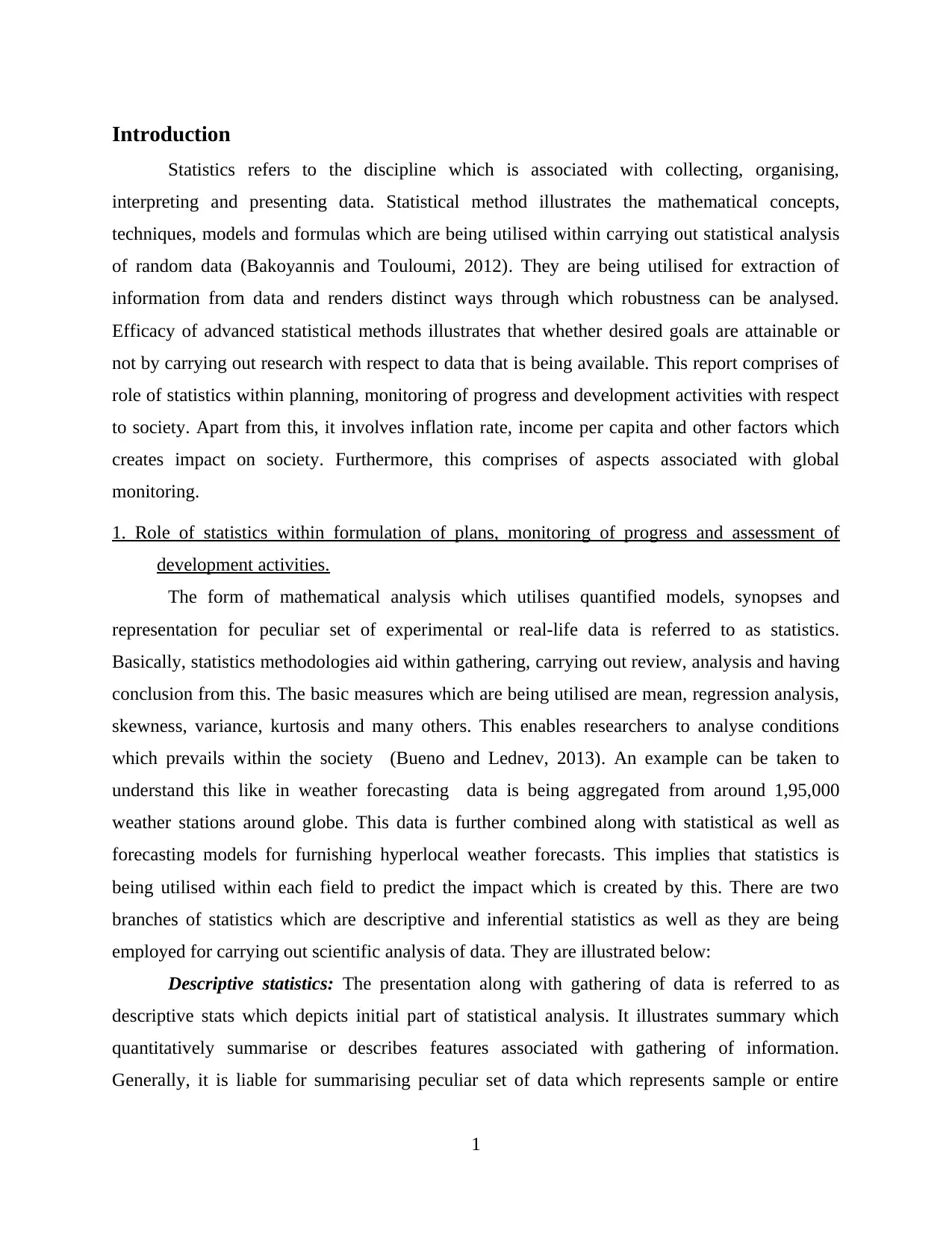
Introduction
Statistics refers to the discipline which is associated with collecting, organising,
interpreting and presenting data. Statistical method illustrates the mathematical concepts,
techniques, models and formulas which are being utilised within carrying out statistical analysis
of random data (Bakoyannis and Touloumi, 2012). They are being utilised for extraction of
information from data and renders distinct ways through which robustness can be analysed.
Efficacy of advanced statistical methods illustrates that whether desired goals are attainable or
not by carrying out research with respect to data that is being available. This report comprises of
role of statistics within planning, monitoring of progress and development activities with respect
to society. Apart from this, it involves inflation rate, income per capita and other factors which
creates impact on society. Furthermore, this comprises of aspects associated with global
monitoring.
1. Role of statistics within formulation of plans, monitoring of progress and assessment of
development activities.
The form of mathematical analysis which utilises quantified models, synopses and
representation for peculiar set of experimental or real-life data is referred to as statistics.
Basically, statistics methodologies aid within gathering, carrying out review, analysis and having
conclusion from this. The basic measures which are being utilised are mean, regression analysis,
skewness, variance, kurtosis and many others. This enables researchers to analyse conditions
which prevails within the society (Bueno and Lednev, 2013). An example can be taken to
understand this like in weather forecasting data is being aggregated from around 1,95,000
weather stations around globe. This data is further combined along with statistical as well as
forecasting models for furnishing hyperlocal weather forecasts. This implies that statistics is
being utilised within each field to predict the impact which is created by this. There are two
branches of statistics which are descriptive and inferential statistics as well as they are being
employed for carrying out scientific analysis of data. They are illustrated below:
Descriptive statistics: The presentation along with gathering of data is referred to as
descriptive stats which depicts initial part of statistical analysis. It illustrates summary which
quantitatively summarise or describes features associated with gathering of information.
Generally, it is liable for summarising peculiar set of data which represents sample or entire
1
Statistics refers to the discipline which is associated with collecting, organising,
interpreting and presenting data. Statistical method illustrates the mathematical concepts,
techniques, models and formulas which are being utilised within carrying out statistical analysis
of random data (Bakoyannis and Touloumi, 2012). They are being utilised for extraction of
information from data and renders distinct ways through which robustness can be analysed.
Efficacy of advanced statistical methods illustrates that whether desired goals are attainable or
not by carrying out research with respect to data that is being available. This report comprises of
role of statistics within planning, monitoring of progress and development activities with respect
to society. Apart from this, it involves inflation rate, income per capita and other factors which
creates impact on society. Furthermore, this comprises of aspects associated with global
monitoring.
1. Role of statistics within formulation of plans, monitoring of progress and assessment of
development activities.
The form of mathematical analysis which utilises quantified models, synopses and
representation for peculiar set of experimental or real-life data is referred to as statistics.
Basically, statistics methodologies aid within gathering, carrying out review, analysis and having
conclusion from this. The basic measures which are being utilised are mean, regression analysis,
skewness, variance, kurtosis and many others. This enables researchers to analyse conditions
which prevails within the society (Bueno and Lednev, 2013). An example can be taken to
understand this like in weather forecasting data is being aggregated from around 1,95,000
weather stations around globe. This data is further combined along with statistical as well as
forecasting models for furnishing hyperlocal weather forecasts. This implies that statistics is
being utilised within each field to predict the impact which is created by this. There are two
branches of statistics which are descriptive and inferential statistics as well as they are being
employed for carrying out scientific analysis of data. They are illustrated below:
Descriptive statistics: The presentation along with gathering of data is referred to as
descriptive stats which depicts initial part of statistical analysis. It illustrates summary which
quantitatively summarise or describes features associated with gathering of information.
Generally, it is liable for summarising peculiar set of data which represents sample or entire
1
Paraphrase This Document
Need a fresh take? Get an instant paraphrase of this document with our AI Paraphraser
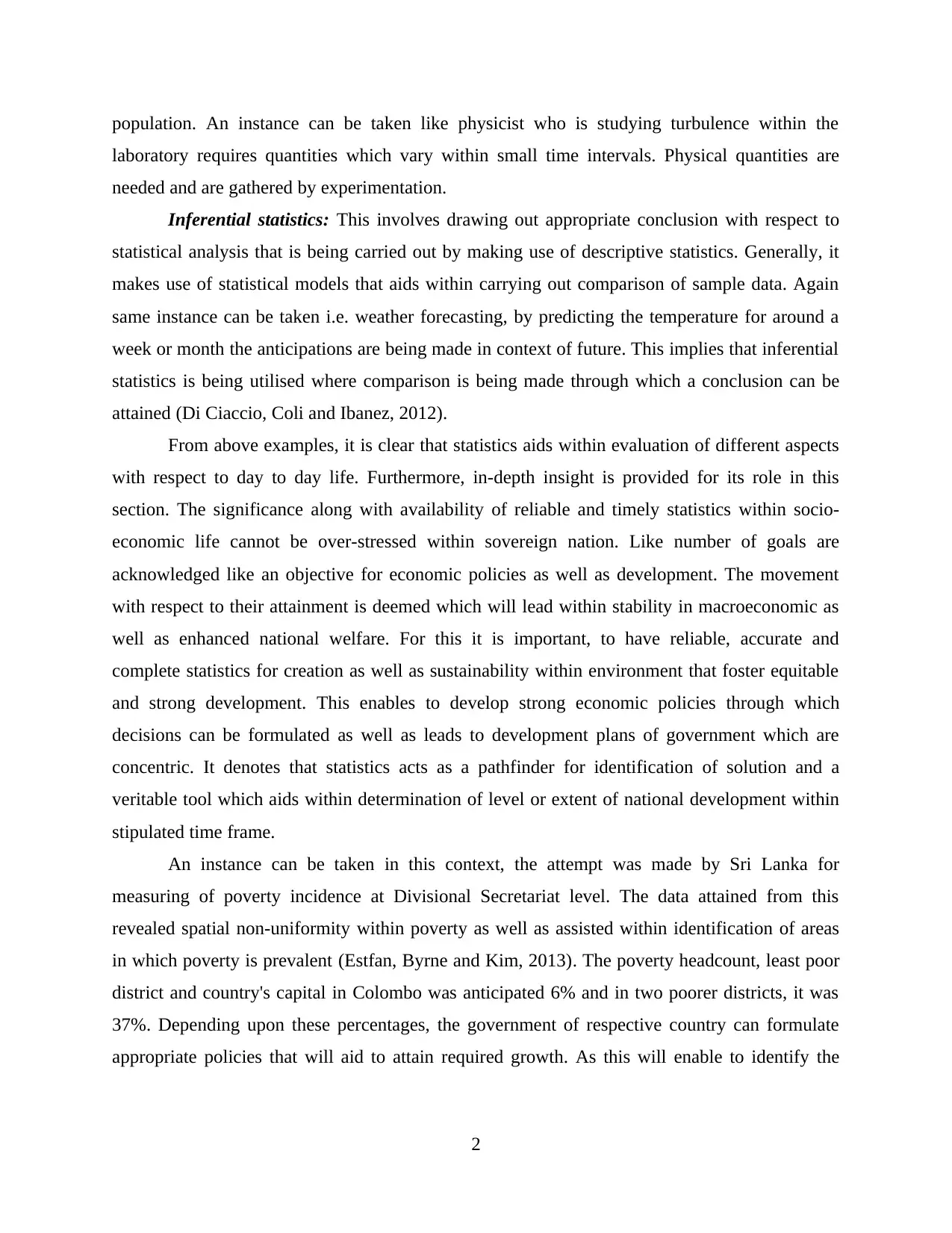
population. An instance can be taken like physicist who is studying turbulence within the
laboratory requires quantities which vary within small time intervals. Physical quantities are
needed and are gathered by experimentation.
Inferential statistics: This involves drawing out appropriate conclusion with respect to
statistical analysis that is being carried out by making use of descriptive statistics. Generally, it
makes use of statistical models that aids within carrying out comparison of sample data. Again
same instance can be taken i.e. weather forecasting, by predicting the temperature for around a
week or month the anticipations are being made in context of future. This implies that inferential
statistics is being utilised where comparison is being made through which a conclusion can be
attained (Di Ciaccio, Coli and Ibanez, 2012).
From above examples, it is clear that statistics aids within evaluation of different aspects
with respect to day to day life. Furthermore, in-depth insight is provided for its role in this
section. The significance along with availability of reliable and timely statistics within socio-
economic life cannot be over-stressed within sovereign nation. Like number of goals are
acknowledged like an objective for economic policies as well as development. The movement
with respect to their attainment is deemed which will lead within stability in macroeconomic as
well as enhanced national welfare. For this it is important, to have reliable, accurate and
complete statistics for creation as well as sustainability within environment that foster equitable
and strong development. This enables to develop strong economic policies through which
decisions can be formulated as well as leads to development plans of government which are
concentric. It denotes that statistics acts as a pathfinder for identification of solution and a
veritable tool which aids within determination of level or extent of national development within
stipulated time frame.
An instance can be taken in this context, the attempt was made by Sri Lanka for
measuring of poverty incidence at Divisional Secretariat level. The data attained from this
revealed spatial non-uniformity within poverty as well as assisted within identification of areas
in which poverty is prevalent (Estfan, Byrne and Kim, 2013). The poverty headcount, least poor
district and country's capital in Colombo was anticipated 6% and in two poorer districts, it was
37%. Depending upon these percentages, the government of respective country can formulate
appropriate policies that will aid to attain required growth. As this will enable to identify the
2
laboratory requires quantities which vary within small time intervals. Physical quantities are
needed and are gathered by experimentation.
Inferential statistics: This involves drawing out appropriate conclusion with respect to
statistical analysis that is being carried out by making use of descriptive statistics. Generally, it
makes use of statistical models that aids within carrying out comparison of sample data. Again
same instance can be taken i.e. weather forecasting, by predicting the temperature for around a
week or month the anticipations are being made in context of future. This implies that inferential
statistics is being utilised where comparison is being made through which a conclusion can be
attained (Di Ciaccio, Coli and Ibanez, 2012).
From above examples, it is clear that statistics aids within evaluation of different aspects
with respect to day to day life. Furthermore, in-depth insight is provided for its role in this
section. The significance along with availability of reliable and timely statistics within socio-
economic life cannot be over-stressed within sovereign nation. Like number of goals are
acknowledged like an objective for economic policies as well as development. The movement
with respect to their attainment is deemed which will lead within stability in macroeconomic as
well as enhanced national welfare. For this it is important, to have reliable, accurate and
complete statistics for creation as well as sustainability within environment that foster equitable
and strong development. This enables to develop strong economic policies through which
decisions can be formulated as well as leads to development plans of government which are
concentric. It denotes that statistics acts as a pathfinder for identification of solution and a
veritable tool which aids within determination of level or extent of national development within
stipulated time frame.
An instance can be taken in this context, the attempt was made by Sri Lanka for
measuring of poverty incidence at Divisional Secretariat level. The data attained from this
revealed spatial non-uniformity within poverty as well as assisted within identification of areas
in which poverty is prevalent (Estfan, Byrne and Kim, 2013). The poverty headcount, least poor
district and country's capital in Colombo was anticipated 6% and in two poorer districts, it was
37%. Depending upon these percentages, the government of respective country can formulate
appropriate policies that will aid to attain required growth. As this will enable to identify the
2
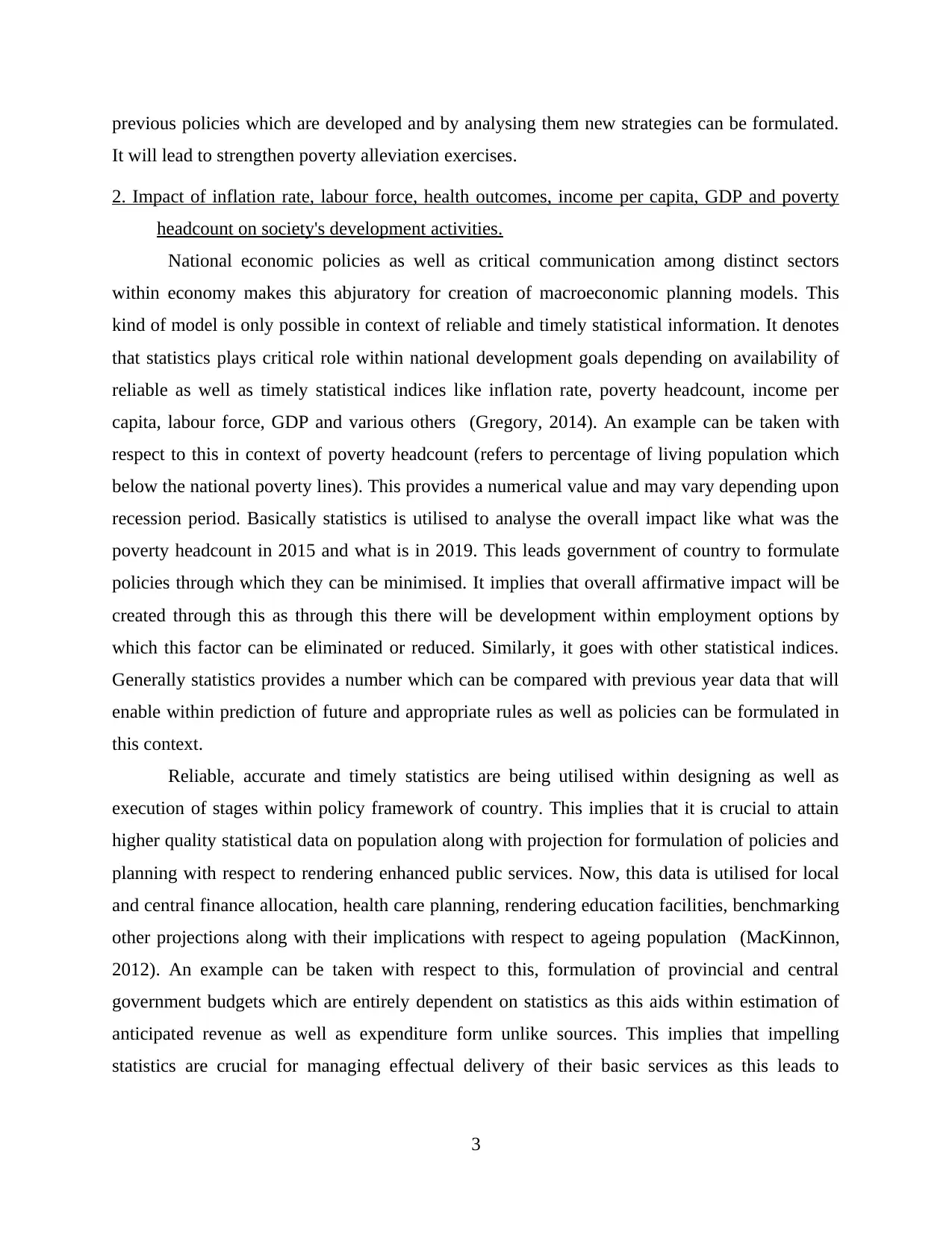
previous policies which are developed and by analysing them new strategies can be formulated.
It will lead to strengthen poverty alleviation exercises.
2. Impact of inflation rate, labour force, health outcomes, income per capita, GDP and poverty
headcount on society's development activities.
National economic policies as well as critical communication among distinct sectors
within economy makes this abjuratory for creation of macroeconomic planning models. This
kind of model is only possible in context of reliable and timely statistical information. It denotes
that statistics plays critical role within national development goals depending on availability of
reliable as well as timely statistical indices like inflation rate, poverty headcount, income per
capita, labour force, GDP and various others (Gregory, 2014). An example can be taken with
respect to this in context of poverty headcount (refers to percentage of living population which
below the national poverty lines). This provides a numerical value and may vary depending upon
recession period. Basically statistics is utilised to analyse the overall impact like what was the
poverty headcount in 2015 and what is in 2019. This leads government of country to formulate
policies through which they can be minimised. It implies that overall affirmative impact will be
created through this as through this there will be development within employment options by
which this factor can be eliminated or reduced. Similarly, it goes with other statistical indices.
Generally statistics provides a number which can be compared with previous year data that will
enable within prediction of future and appropriate rules as well as policies can be formulated in
this context.
Reliable, accurate and timely statistics are being utilised within designing as well as
execution of stages within policy framework of country. This implies that it is crucial to attain
higher quality statistical data on population along with projection for formulation of policies and
planning with respect to rendering enhanced public services. Now, this data is utilised for local
and central finance allocation, health care planning, rendering education facilities, benchmarking
other projections along with their implications with respect to ageing population (MacKinnon,
2012). An example can be taken with respect to this, formulation of provincial and central
government budgets which are entirely dependent on statistics as this aids within estimation of
anticipated revenue as well as expenditure form unlike sources. This implies that impelling
statistics are crucial for managing effectual delivery of their basic services as this leads to
3
It will lead to strengthen poverty alleviation exercises.
2. Impact of inflation rate, labour force, health outcomes, income per capita, GDP and poverty
headcount on society's development activities.
National economic policies as well as critical communication among distinct sectors
within economy makes this abjuratory for creation of macroeconomic planning models. This
kind of model is only possible in context of reliable and timely statistical information. It denotes
that statistics plays critical role within national development goals depending on availability of
reliable as well as timely statistical indices like inflation rate, poverty headcount, income per
capita, labour force, GDP and various others (Gregory, 2014). An example can be taken with
respect to this in context of poverty headcount (refers to percentage of living population which
below the national poverty lines). This provides a numerical value and may vary depending upon
recession period. Basically statistics is utilised to analyse the overall impact like what was the
poverty headcount in 2015 and what is in 2019. This leads government of country to formulate
policies through which they can be minimised. It implies that overall affirmative impact will be
created through this as through this there will be development within employment options by
which this factor can be eliminated or reduced. Similarly, it goes with other statistical indices.
Generally statistics provides a number which can be compared with previous year data that will
enable within prediction of future and appropriate rules as well as policies can be formulated in
this context.
Reliable, accurate and timely statistics are being utilised within designing as well as
execution of stages within policy framework of country. This implies that it is crucial to attain
higher quality statistical data on population along with projection for formulation of policies and
planning with respect to rendering enhanced public services. Now, this data is utilised for local
and central finance allocation, health care planning, rendering education facilities, benchmarking
other projections along with their implications with respect to ageing population (MacKinnon,
2012). An example can be taken with respect to this, formulation of provincial and central
government budgets which are entirely dependent on statistics as this aids within estimation of
anticipated revenue as well as expenditure form unlike sources. This implies that impelling
statistics are crucial for managing effectual delivery of their basic services as this leads to
3
⊘ This is a preview!⊘
Do you want full access?
Subscribe today to unlock all pages.

Trusted by 1+ million students worldwide
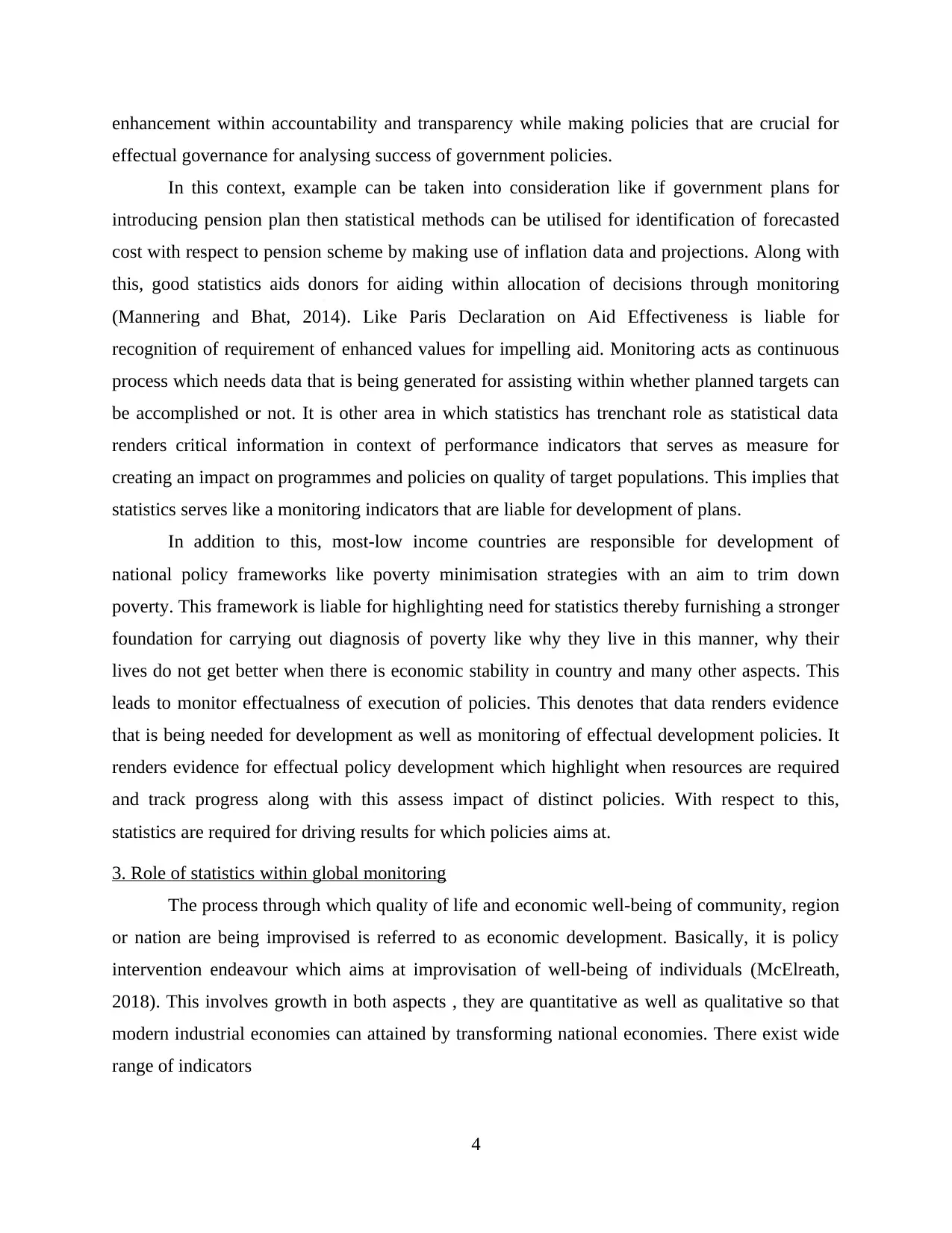
enhancement within accountability and transparency while making policies that are crucial for
effectual governance for analysing success of government policies.
In this context, example can be taken into consideration like if government plans for
introducing pension plan then statistical methods can be utilised for identification of forecasted
cost with respect to pension scheme by making use of inflation data and projections. Along with
this, good statistics aids donors for aiding within allocation of decisions through monitoring
(Mannering and Bhat, 2014). Like Paris Declaration on Aid Effectiveness is liable for
recognition of requirement of enhanced values for impelling aid. Monitoring acts as continuous
process which needs data that is being generated for assisting within whether planned targets can
be accomplished or not. It is other area in which statistics has trenchant role as statistical data
renders critical information in context of performance indicators that serves as measure for
creating an impact on programmes and policies on quality of target populations. This implies that
statistics serves like a monitoring indicators that are liable for development of plans.
In addition to this, most-low income countries are responsible for development of
national policy frameworks like poverty minimisation strategies with an aim to trim down
poverty. This framework is liable for highlighting need for statistics thereby furnishing a stronger
foundation for carrying out diagnosis of poverty like why they live in this manner, why their
lives do not get better when there is economic stability in country and many other aspects. This
leads to monitor effectualness of execution of policies. This denotes that data renders evidence
that is being needed for development as well as monitoring of effectual development policies. It
renders evidence for effectual policy development which highlight when resources are required
and track progress along with this assess impact of distinct policies. With respect to this,
statistics are required for driving results for which policies aims at.
3. Role of statistics within global monitoring
The process through which quality of life and economic well-being of community, region
or nation are being improvised is referred to as economic development. Basically, it is policy
intervention endeavour which aims at improvisation of well-being of individuals (McElreath,
2018). This involves growth in both aspects , they are quantitative as well as qualitative so that
modern industrial economies can attained by transforming national economies. There exist wide
range of indicators
4
effectual governance for analysing success of government policies.
In this context, example can be taken into consideration like if government plans for
introducing pension plan then statistical methods can be utilised for identification of forecasted
cost with respect to pension scheme by making use of inflation data and projections. Along with
this, good statistics aids donors for aiding within allocation of decisions through monitoring
(Mannering and Bhat, 2014). Like Paris Declaration on Aid Effectiveness is liable for
recognition of requirement of enhanced values for impelling aid. Monitoring acts as continuous
process which needs data that is being generated for assisting within whether planned targets can
be accomplished or not. It is other area in which statistics has trenchant role as statistical data
renders critical information in context of performance indicators that serves as measure for
creating an impact on programmes and policies on quality of target populations. This implies that
statistics serves like a monitoring indicators that are liable for development of plans.
In addition to this, most-low income countries are responsible for development of
national policy frameworks like poverty minimisation strategies with an aim to trim down
poverty. This framework is liable for highlighting need for statistics thereby furnishing a stronger
foundation for carrying out diagnosis of poverty like why they live in this manner, why their
lives do not get better when there is economic stability in country and many other aspects. This
leads to monitor effectualness of execution of policies. This denotes that data renders evidence
that is being needed for development as well as monitoring of effectual development policies. It
renders evidence for effectual policy development which highlight when resources are required
and track progress along with this assess impact of distinct policies. With respect to this,
statistics are required for driving results for which policies aims at.
3. Role of statistics within global monitoring
The process through which quality of life and economic well-being of community, region
or nation are being improvised is referred to as economic development. Basically, it is policy
intervention endeavour which aims at improvisation of well-being of individuals (McElreath,
2018). This involves growth in both aspects , they are quantitative as well as qualitative so that
modern industrial economies can attained by transforming national economies. There exist wide
range of indicators
4
Paraphrase This Document
Need a fresh take? Get an instant paraphrase of this document with our AI Paraphraser
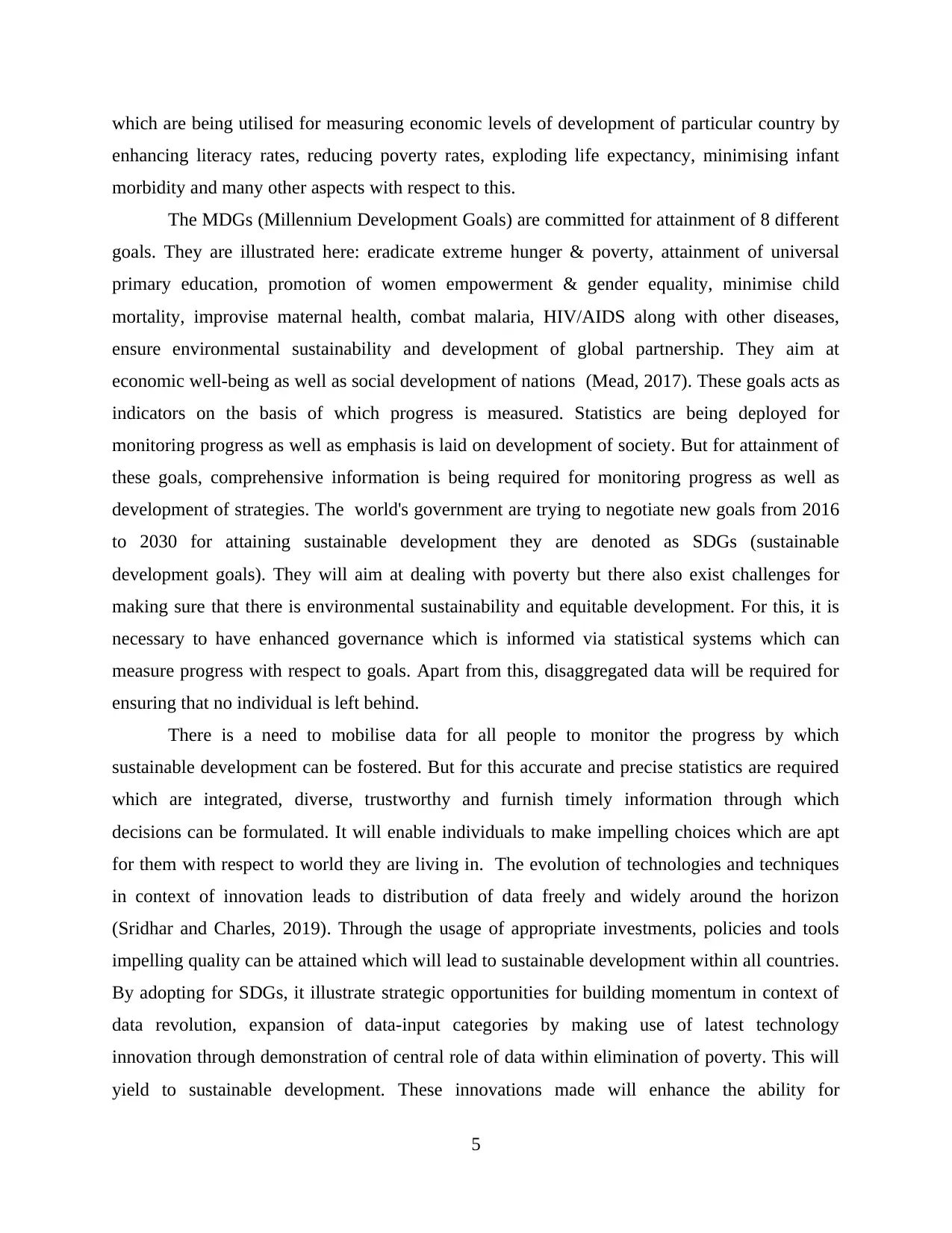
which are being utilised for measuring economic levels of development of particular country by
enhancing literacy rates, reducing poverty rates, exploding life expectancy, minimising infant
morbidity and many other aspects with respect to this.
The MDGs (Millennium Development Goals) are committed for attainment of 8 different
goals. They are illustrated here: eradicate extreme hunger & poverty, attainment of universal
primary education, promotion of women empowerment & gender equality, minimise child
mortality, improvise maternal health, combat malaria, HIV/AIDS along with other diseases,
ensure environmental sustainability and development of global partnership. They aim at
economic well-being as well as social development of nations (Mead, 2017). These goals acts as
indicators on the basis of which progress is measured. Statistics are being deployed for
monitoring progress as well as emphasis is laid on development of society. But for attainment of
these goals, comprehensive information is being required for monitoring progress as well as
development of strategies. The world's government are trying to negotiate new goals from 2016
to 2030 for attaining sustainable development they are denoted as SDGs (sustainable
development goals). They will aim at dealing with poverty but there also exist challenges for
making sure that there is environmental sustainability and equitable development. For this, it is
necessary to have enhanced governance which is informed via statistical systems which can
measure progress with respect to goals. Apart from this, disaggregated data will be required for
ensuring that no individual is left behind.
There is a need to mobilise data for all people to monitor the progress by which
sustainable development can be fostered. But for this accurate and precise statistics are required
which are integrated, diverse, trustworthy and furnish timely information through which
decisions can be formulated. It will enable individuals to make impelling choices which are apt
for them with respect to world they are living in. The evolution of technologies and techniques
in context of innovation leads to distribution of data freely and widely around the horizon
(Sridhar and Charles, 2019). Through the usage of appropriate investments, policies and tools
impelling quality can be attained which will lead to sustainable development within all countries.
By adopting for SDGs, it illustrate strategic opportunities for building momentum in context of
data revolution, expansion of data-input categories by making use of latest technology
innovation through demonstration of central role of data within elimination of poverty. This will
yield to sustainable development. These innovations made will enhance the ability for
5
enhancing literacy rates, reducing poverty rates, exploding life expectancy, minimising infant
morbidity and many other aspects with respect to this.
The MDGs (Millennium Development Goals) are committed for attainment of 8 different
goals. They are illustrated here: eradicate extreme hunger & poverty, attainment of universal
primary education, promotion of women empowerment & gender equality, minimise child
mortality, improvise maternal health, combat malaria, HIV/AIDS along with other diseases,
ensure environmental sustainability and development of global partnership. They aim at
economic well-being as well as social development of nations (Mead, 2017). These goals acts as
indicators on the basis of which progress is measured. Statistics are being deployed for
monitoring progress as well as emphasis is laid on development of society. But for attainment of
these goals, comprehensive information is being required for monitoring progress as well as
development of strategies. The world's government are trying to negotiate new goals from 2016
to 2030 for attaining sustainable development they are denoted as SDGs (sustainable
development goals). They will aim at dealing with poverty but there also exist challenges for
making sure that there is environmental sustainability and equitable development. For this, it is
necessary to have enhanced governance which is informed via statistical systems which can
measure progress with respect to goals. Apart from this, disaggregated data will be required for
ensuring that no individual is left behind.
There is a need to mobilise data for all people to monitor the progress by which
sustainable development can be fostered. But for this accurate and precise statistics are required
which are integrated, diverse, trustworthy and furnish timely information through which
decisions can be formulated. It will enable individuals to make impelling choices which are apt
for them with respect to world they are living in. The evolution of technologies and techniques
in context of innovation leads to distribution of data freely and widely around the horizon
(Sridhar and Charles, 2019). Through the usage of appropriate investments, policies and tools
impelling quality can be attained which will lead to sustainable development within all countries.
By adopting for SDGs, it illustrate strategic opportunities for building momentum in context of
data revolution, expansion of data-input categories by making use of latest technology
innovation through demonstration of central role of data within elimination of poverty. This will
yield to sustainable development. These innovations made will enhance the ability for
5
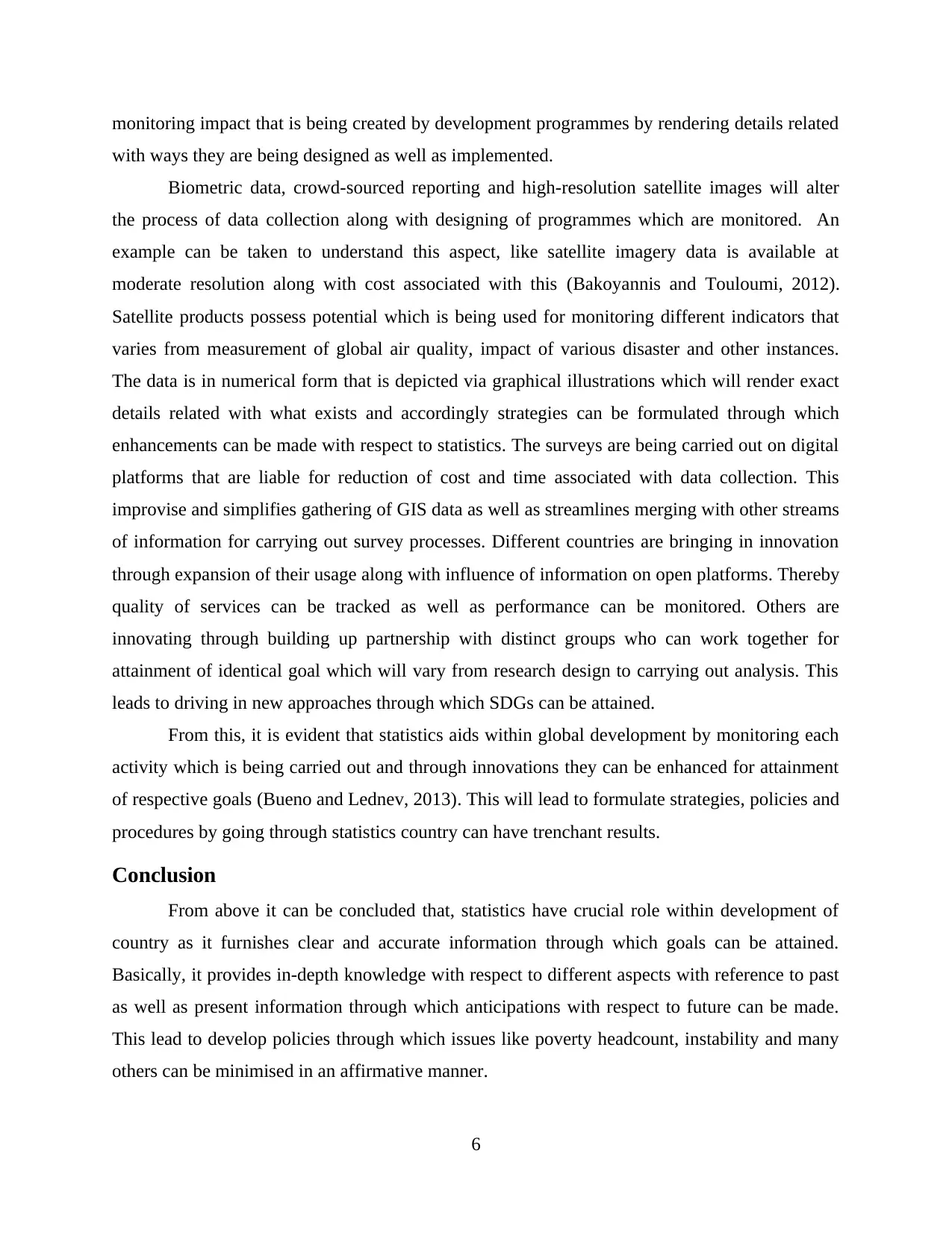
monitoring impact that is being created by development programmes by rendering details related
with ways they are being designed as well as implemented.
Biometric data, crowd-sourced reporting and high-resolution satellite images will alter
the process of data collection along with designing of programmes which are monitored. An
example can be taken to understand this aspect, like satellite imagery data is available at
moderate resolution along with cost associated with this (Bakoyannis and Touloumi, 2012).
Satellite products possess potential which is being used for monitoring different indicators that
varies from measurement of global air quality, impact of various disaster and other instances.
The data is in numerical form that is depicted via graphical illustrations which will render exact
details related with what exists and accordingly strategies can be formulated through which
enhancements can be made with respect to statistics. The surveys are being carried out on digital
platforms that are liable for reduction of cost and time associated with data collection. This
improvise and simplifies gathering of GIS data as well as streamlines merging with other streams
of information for carrying out survey processes. Different countries are bringing in innovation
through expansion of their usage along with influence of information on open platforms. Thereby
quality of services can be tracked as well as performance can be monitored. Others are
innovating through building up partnership with distinct groups who can work together for
attainment of identical goal which will vary from research design to carrying out analysis. This
leads to driving in new approaches through which SDGs can be attained.
From this, it is evident that statistics aids within global development by monitoring each
activity which is being carried out and through innovations they can be enhanced for attainment
of respective goals (Bueno and Lednev, 2013). This will lead to formulate strategies, policies and
procedures by going through statistics country can have trenchant results.
Conclusion
From above it can be concluded that, statistics have crucial role within development of
country as it furnishes clear and accurate information through which goals can be attained.
Basically, it provides in-depth knowledge with respect to different aspects with reference to past
as well as present information through which anticipations with respect to future can be made.
This lead to develop policies through which issues like poverty headcount, instability and many
others can be minimised in an affirmative manner.
6
with ways they are being designed as well as implemented.
Biometric data, crowd-sourced reporting and high-resolution satellite images will alter
the process of data collection along with designing of programmes which are monitored. An
example can be taken to understand this aspect, like satellite imagery data is available at
moderate resolution along with cost associated with this (Bakoyannis and Touloumi, 2012).
Satellite products possess potential which is being used for monitoring different indicators that
varies from measurement of global air quality, impact of various disaster and other instances.
The data is in numerical form that is depicted via graphical illustrations which will render exact
details related with what exists and accordingly strategies can be formulated through which
enhancements can be made with respect to statistics. The surveys are being carried out on digital
platforms that are liable for reduction of cost and time associated with data collection. This
improvise and simplifies gathering of GIS data as well as streamlines merging with other streams
of information for carrying out survey processes. Different countries are bringing in innovation
through expansion of their usage along with influence of information on open platforms. Thereby
quality of services can be tracked as well as performance can be monitored. Others are
innovating through building up partnership with distinct groups who can work together for
attainment of identical goal which will vary from research design to carrying out analysis. This
leads to driving in new approaches through which SDGs can be attained.
From this, it is evident that statistics aids within global development by monitoring each
activity which is being carried out and through innovations they can be enhanced for attainment
of respective goals (Bueno and Lednev, 2013). This will lead to formulate strategies, policies and
procedures by going through statistics country can have trenchant results.
Conclusion
From above it can be concluded that, statistics have crucial role within development of
country as it furnishes clear and accurate information through which goals can be attained.
Basically, it provides in-depth knowledge with respect to different aspects with reference to past
as well as present information through which anticipations with respect to future can be made.
This lead to develop policies through which issues like poverty headcount, instability and many
others can be minimised in an affirmative manner.
6
⊘ This is a preview!⊘
Do you want full access?
Subscribe today to unlock all pages.

Trusted by 1+ million students worldwide
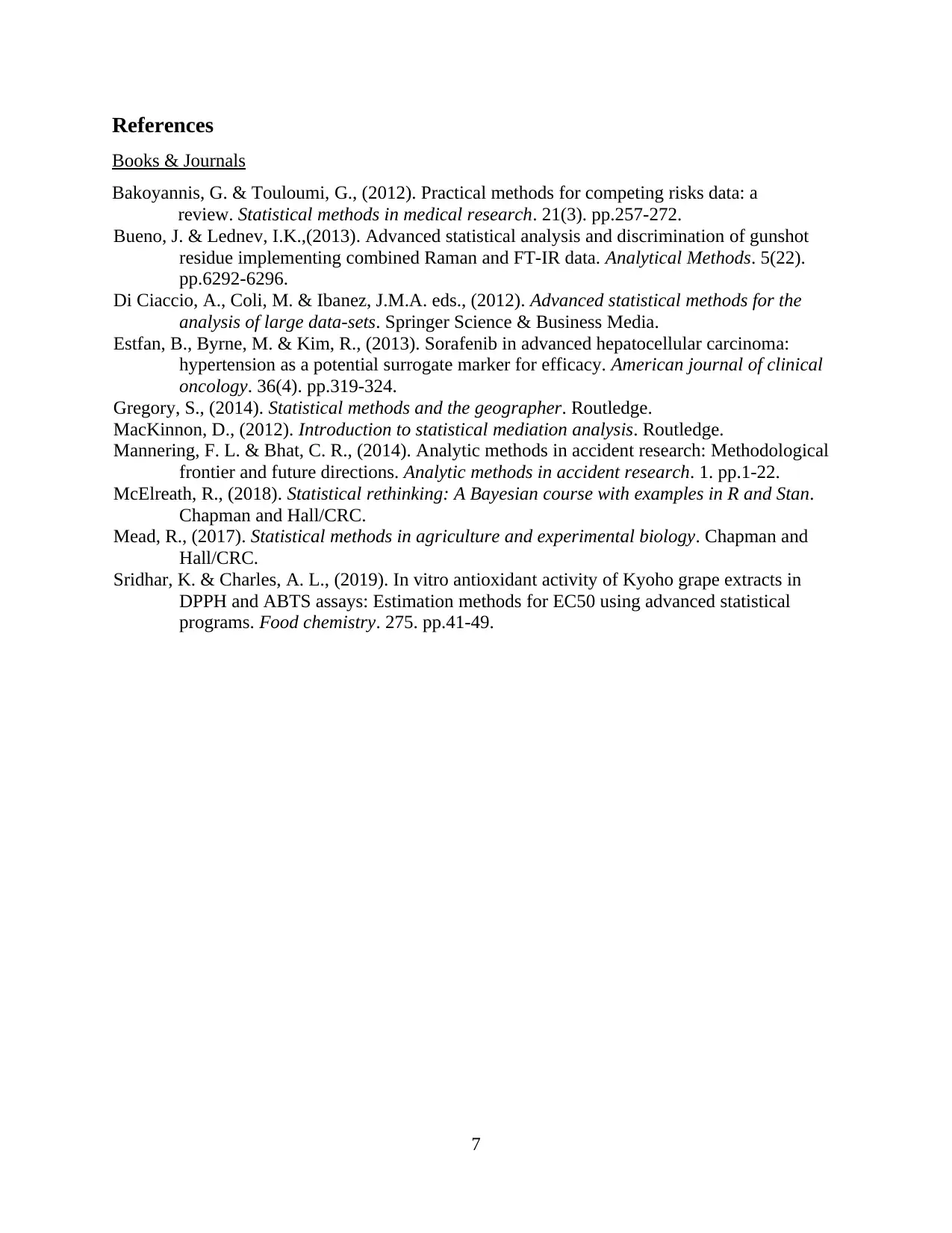
References
Books & Journals
Bakoyannis, G. & Touloumi, G., (2012). Practical methods for competing risks data: a
review. Statistical methods in medical research. 21(3). pp.257-272.
Bueno, J. & Lednev, I.K.,(2013). Advanced statistical analysis and discrimination of gunshot
residue implementing combined Raman and FT-IR data. Analytical Methods. 5(22).
pp.6292-6296.
Di Ciaccio, A., Coli, M. & Ibanez, J.M.A. eds., (2012). Advanced statistical methods for the
analysis of large data-sets. Springer Science & Business Media.
Estfan, B., Byrne, M. & Kim, R., (2013). Sorafenib in advanced hepatocellular carcinoma:
hypertension as a potential surrogate marker for efficacy. American journal of clinical
oncology. 36(4). pp.319-324.
Gregory, S., (2014). Statistical methods and the geographer. Routledge.
MacKinnon, D., (2012). Introduction to statistical mediation analysis. Routledge.
Mannering, F. L. & Bhat, C. R., (2014). Analytic methods in accident research: Methodological
frontier and future directions. Analytic methods in accident research. 1. pp.1-22.
McElreath, R., (2018). Statistical rethinking: A Bayesian course with examples in R and Stan.
Chapman and Hall/CRC.
Mead, R., (2017). Statistical methods in agriculture and experimental biology. Chapman and
Hall/CRC.
Sridhar, K. & Charles, A. L., (2019). In vitro antioxidant activity of Kyoho grape extracts in
DPPH and ABTS assays: Estimation methods for EC50 using advanced statistical
programs. Food chemistry. 275. pp.41-49.
7
Books & Journals
Bakoyannis, G. & Touloumi, G., (2012). Practical methods for competing risks data: a
review. Statistical methods in medical research. 21(3). pp.257-272.
Bueno, J. & Lednev, I.K.,(2013). Advanced statistical analysis and discrimination of gunshot
residue implementing combined Raman and FT-IR data. Analytical Methods. 5(22).
pp.6292-6296.
Di Ciaccio, A., Coli, M. & Ibanez, J.M.A. eds., (2012). Advanced statistical methods for the
analysis of large data-sets. Springer Science & Business Media.
Estfan, B., Byrne, M. & Kim, R., (2013). Sorafenib in advanced hepatocellular carcinoma:
hypertension as a potential surrogate marker for efficacy. American journal of clinical
oncology. 36(4). pp.319-324.
Gregory, S., (2014). Statistical methods and the geographer. Routledge.
MacKinnon, D., (2012). Introduction to statistical mediation analysis. Routledge.
Mannering, F. L. & Bhat, C. R., (2014). Analytic methods in accident research: Methodological
frontier and future directions. Analytic methods in accident research. 1. pp.1-22.
McElreath, R., (2018). Statistical rethinking: A Bayesian course with examples in R and Stan.
Chapman and Hall/CRC.
Mead, R., (2017). Statistical methods in agriculture and experimental biology. Chapman and
Hall/CRC.
Sridhar, K. & Charles, A. L., (2019). In vitro antioxidant activity of Kyoho grape extracts in
DPPH and ABTS assays: Estimation methods for EC50 using advanced statistical
programs. Food chemistry. 275. pp.41-49.
7
1 out of 10
Related Documents
Your All-in-One AI-Powered Toolkit for Academic Success.
+13062052269
info@desklib.com
Available 24*7 on WhatsApp / Email
![[object Object]](/_next/static/media/star-bottom.7253800d.svg)
Unlock your academic potential
Copyright © 2020–2025 A2Z Services. All Rights Reserved. Developed and managed by ZUCOL.




